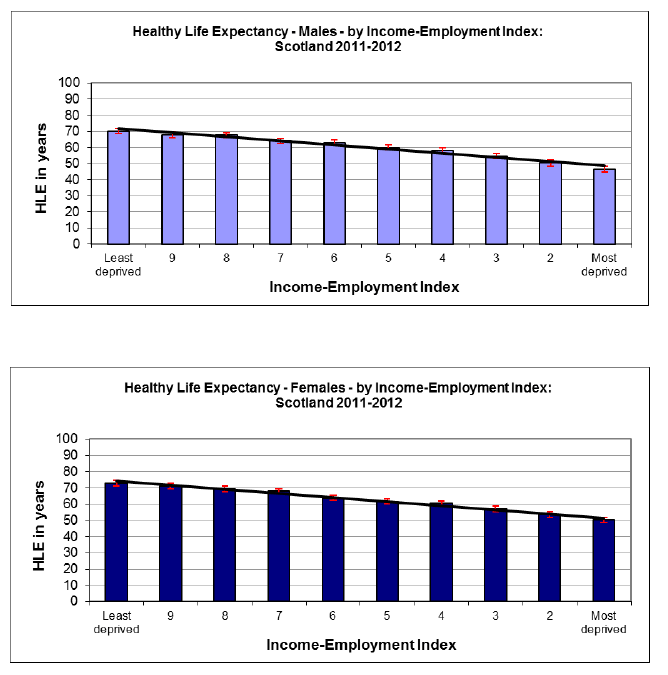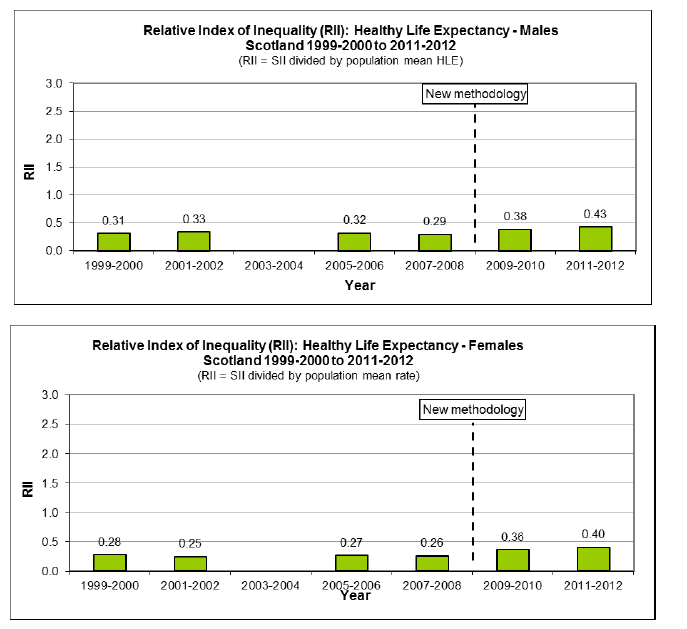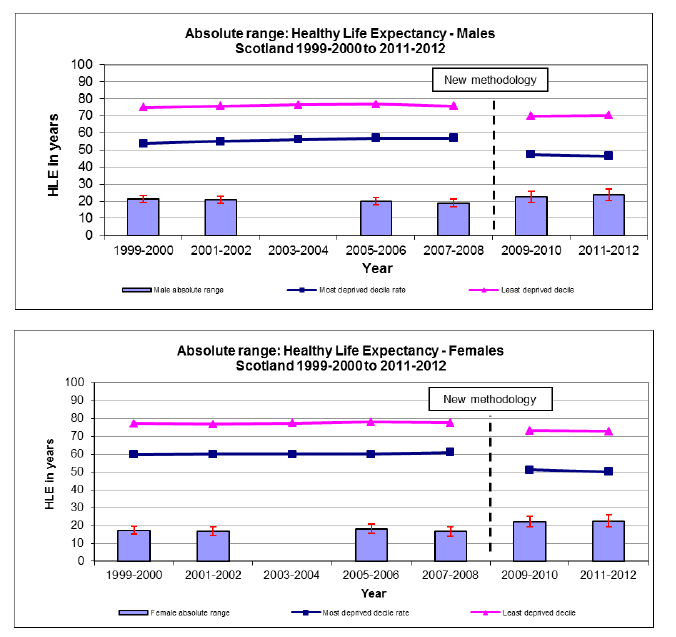Long-term Monitoring of Health Inequalities: Headline Indicators - October 2013
Annual update of the 'Long-term Monitoring of Health Inequalities' headline indicators.
This document is part of a collection
Healthy Life Expectancy at birth
Summary
- There continue to be inequalities in both relative and absolute terms. Between 2009-2010 and 2011-2012, although inequalities appear to have widened slightly, the changes were not statistically significant. Changes to the methodology from 2009 mean comparisons with earlier years cannot be made.
The Healthy Life Expectancy (HLE) indicator is based on two years of data to ensure large enough sample sizes.
Between 1999-2000 and 2007-2008, HLE increased by 3 years (4.5%) for males and by 2.3 years (3.4%) for females. In 2009, the format of the self-assessed health question, on which healthy life expectancy data is based, was changed to align with the European Union, leading to a major discontinuity in the series. The markedly lower estimates of HLE at birth from 2009 onwards cannot be considered as part of the same series as earlier years. A technical paper by the Scottish Public Health Observatory (ScotPHO) has more information on this change.[5]
In 2011-2012, HLE at Scotland level was 59.8 years for males and 62.3 years for females, broadly in line with the 2009-2010 figures. HLE is lower in deprived areas than in areas of low deprivation. In 2011-2012, HLE of those living in the 10% most deprived areas was 23.8 years lower for males and 22.6 years lower for females than HLE of those living in the 10% least deprived areas.
The difference between HLE and life expectancy, i.e. expected years spent in 'not good' health, is greater in more deprived areas. In the most deprived areas, males spend 22.7 years in 'not good' health, compared to 11.9 years in the least deprived areas and 16.7 years for males in Scotland as a whole. Females in the most deprived areas spend 26.1 years in 'not good' health in the most deprived areas, compared with 12.0 years in the least deprived areas and 18.5 years for females in Scotland as a whole.
Inequalities gradient in the most recent year available

Note: the red bars indicate 95% confidence limits of each HLE estimate.
Relative Index of Inequality (RII) over time

Data not available for 2003-2004
Absolute range over time

Data not available for 2003-2004.
The red bars for each column indicate the uncertainties in each estimate based on 95% confidence intervals around each HLE estimate.
Scale / context
Current Methodology (5 point scale of self-assessed health), 2009-2010 and 2011-2012
Men
| Male HLE in years | 95%LL |
95%UL |
Male LE in years |
95%LL |
95%UL |
Estimated years spent in 'not good' health |
|
|---|---|---|---|---|---|---|---|
| 2009-2010 |
|||||||
| Scotland |
59.9 |
59.4 |
60.4 |
76.1 |
76.0 |
76.2 |
16.2 |
| Most deprived decile |
47.4 |
45.8 |
49.0 |
68.7 |
68.3 |
69.1 |
21.3 |
| Least deprived decile |
69.9 |
68.2 |
71.6 |
82.0 |
81.6 |
82.3 |
12.1 |
| 2011-2012 |
|||||||
| Scotland |
59.8 |
59.3 |
59.3 |
76.6 |
76.4 |
76.7 |
16.7 |
| Most deprived decile |
46.4 |
44.7 |
44.7 |
69.2 |
68.8 |
69.6 |
22.7 |
| Least deprived decile |
70.2 |
68.5 |
68.5 |
82.1 |
81.8 |
82.4 |
11.9 |
Women
| Female HLE in years |
95%LL |
95%UL |
Female LE in years |
95%LL |
95%UL |
Estimated years spent in 'not good' health |
|
|---|---|---|---|---|---|---|---|
| 2009-2010 |
|||||||
| Scotland |
62.1 |
61.6 |
62.6 |
80.6 |
80.5 |
80.8 |
18.6 |
| Most deprived decile |
51.1 |
49.6 |
52.6 |
76.1 |
75.7 |
76.5 |
24.9 |
| Least deprived decile |
73.2 |
71.7 |
74.7 |
84.8 |
84.5 |
85.1 |
11.6 |
| 2011-2012 |
|||||||
| Scotland |
62.3 |
61.8 |
62.9 |
80.9 |
80.8 |
81.0 |
18.5 |
| Most deprived decile |
50.2 |
48.6 |
51.8 |
76.4 |
76.0 |
76.7 |
26.1 |
| Least deprived decile |
72.8 |
71.2 |
74.5 |
84.8 |
84.5 |
85.2 |
12.0 |
1. From 2009, self-assessed health was measured on a five-point scale (Very good, Good, Fair, Bad, Very bad). For summary purposes, the final three categories (Fair, Bad, Very Bad) are collectively referred to as 'Not good health'. This is different to the category of 'Poor health' in the subsequent two tables.
Previous Methodology (3-point scale of self-assessed health), 1999-2000 to 2007-2008
Men
| Male HLE in years |
95%LL |
95%UL |
Male LE in years |
95%LL |
95%UL |
Estimated years spent in poor health1 |
|
|---|---|---|---|---|---|---|---|
| 1999-2000 |
|||||||
| Scotland |
65.0 |
64.7 |
65.4 |
73.0 |
72.8 |
73.1 |
7.9 |
| Most deprived decile |
53.7 |
52.6 |
54.8 |
65.8 |
65.4 |
66.3 |
12.1 |
| Least deprived decile |
75.0 |
74.0 |
75.9 |
78.6 |
78.3 |
79.0 |
3.7 |
| 2001-2002 |
|||||||
| Scotland |
65.9 |
65.6 |
66.2 |
73.4 |
73.3 |
73.5 |
7.5 |
| Most deprived decile |
55.0 |
53.9 |
56.1 |
65.8 |
65.4 |
66.3 |
10.8 |
| Least deprived decile |
75.7 |
74.8 |
76.6 |
79.5 |
79.1 |
79.9 |
3.8 |
| 2003-2004 |
|||||||
| Scotland |
74.0 |
73.9 |
74.1 |
- |
|||
| Most deprived decile |
66.3 |
65.9 |
66.8 |
- |
|||
| Least deprived decile |
79.7 |
79.3 |
80.0 |
- |
|||
| 2005-2006 |
|||||||
| Scotland |
67.4 |
67.1 |
67.7 |
74.8 |
74.7 |
74.9 |
7.4 |
| Most deprived decile |
57.0 |
55.9 |
58.1 |
67.5 |
67.1 |
67.9 |
10.5 |
| Least deprived decile |
76.8 |
75.8 |
77.8 |
80.7 |
80.4 |
81.1 |
3.9 |
| 2007-2008 - revised |
|||||||
| Scotland |
68.0 |
67.6 |
68.3 |
75.1 |
75.0 |
75.2 |
7.1 |
| Most deprived decile |
56.9 |
55.7 |
58.1 |
67.6 |
67.2 |
68.0 |
10.6 |
| Least deprived decile |
75.8 |
74.7 |
76.9 |
80.9 |
80.6 |
81.3 |
5.1 |
Women
| Female HLE in years |
95%LL |
95%UL |
Female LE in years |
95%LL |
95%UL |
Estimated years spent in poor health1 |
|
|---|---|---|---|---|---|---|---|
| 1999-2000 |
|||||||
| Scotland |
68.2 |
67.8 |
68.5 |
78.4 |
78.3 |
78.5 |
10.3 |
| Most deprived decile |
59.8 |
58.6 |
61.0 |
74.2 |
73.9 |
74.6 |
14.4 |
| Least deprived decile |
77.1 |
76.1 |
78.1 |
81.8 |
81.5 |
82.1 |
4.7 |
| 2001-2002 |
|||||||
| Scotland |
69.2 |
68.9 |
69.6 |
78.9 |
78.8 |
79.0 |
9.6 |
| Most deprived decile |
60.0 |
58.8 |
61.1 |
74.6 |
74.2 |
74.9 |
14.6 |
| Least deprived decile |
76.8 |
75.6 |
77.9 |
82.4 |
82.1 |
82.8 |
5.7 |
| 2003-2004 |
|||||||
| Scotland |
79.1 |
79.0 |
79.2 |
- |
|||
| Most deprived decile |
74.8 |
74.4 |
75.2 |
- |
|||
| Least deprived decile |
83.0 |
82.6 |
83.3 |
- |
|||
| 2005-2006 |
|||||||
| Scotland |
69.6 |
69.2 |
70.0 |
79.7 |
79.6 |
79.8 |
10.1 |
| Most deprived decile |
59.9 |
58.7 |
61.1 |
75.1 |
74.7 |
75.5 |
15.2 |
| Least deprived decile |
78.1 |
76.8 |
79.3 |
84.2 |
83.9 |
84.6 |
6.2 |
| 2007-2008 |
|||||||
| Scotland |
70.5 |
70.1 |
70.9 |
80.0 |
79.8 |
80.1 |
9.5 |
| Most deprived decile |
60.9 |
59.5 |
62.2 |
75.5 |
75.2 |
75.9 |
14.7 |
| Least deprived decile |
77.6 |
76.3 |
78.8 |
84.3 |
84.0 |
84.6 |
6.7 |
1. Prior to 2009, self-assessed health was measured on a three-point scale (Good, Fairly good, Not good). For summary purposes, 'Not good' responses were counted as 'Poor health'. This is not comparable to the category of 'Not good health' used from 2009 onwards.
Contact
Email: Craig Kellock
There is a problem
Thanks for your feedback